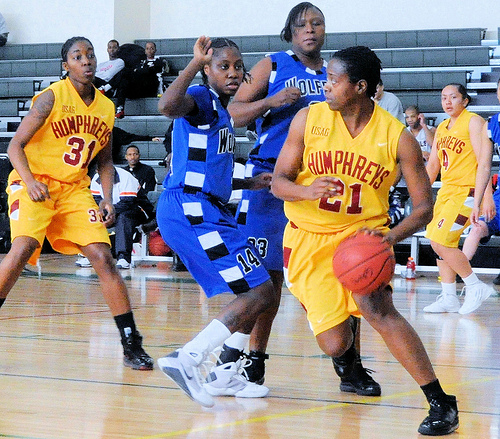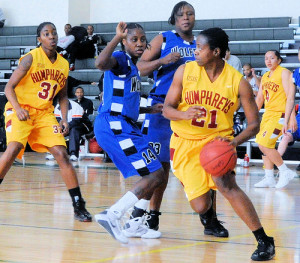5 Points of Emphasis for when a Ball Handler is being Trapped


Being Trapped can be one of the more troubling experiences a ball handler can have in the game of basketball. If trapped effectively the dribbler will only have a few moments from the initial trapping situation starting, to when they are fully contained by the defenders.
There are a some key points every coach should be discussing with their players about dealing with a situation in which they can become trapped.
Pause before Dribbling
Offensive players in their eagerness to move the ball quickly from one end of the floor to the other often catch and go into a run straight away. In looking to avoid being trapped catching on the run and moving straight into a dribbling situation can actually just make the defences job a lot easier.
The outlet should look to catch and pivot towards the frontcourt before moving. This will allow for greater vision and awareness of where the gaps and seams are in the trapping defence so they can then move to exploit these opportunities.
As players become more aware of the space around them this tactic might be less and less valuable, but initially stopping to assess the situation for many ball handlers improves decision making (even if it does slow the play).
A common issue when pausing is that players can tend to turn away from the frontcourt. This will need to be an aspect of pivoting a coach will need to work against. Pivoting away from the frontcourt only serves to limit the options of the ball handler in dribbling and passing.
Utilise the Pass Fake
Most players will have heard the mantra “Fake a Pass, to make a Pass”. Like most things, the simplest actions often provide the best results and it does not matter if you are in the full court or the half court the Pass Fake is effective (before or after the dribble).
There is not secret to using the Pass Fake, but with practice, it will become a great tool when used wisely.
Keep the Dribble Alive
A common reaction to a trapping situation is for the dribbler to pick the ball up in an attempt to quicken the possibility of making a pass. This is really common and something many players struggle with even at the elite or senior levels of the sport of basketball.
To overcome this reaction players just need to be drilled in basic skills such as the reverse dribble which will help the player to maintain distance between themselves and the defenders involved in the trap. This skill will need to be practiced in game like situations to have full effect, so the player does not back themselves into a corner only to become trapped in a smaller area of the court.
By looking to create space between the defenders and the ball, this will force the defenders to move if they wish to create a trap. A moving defender is an easier defender to beat off the dribble as they must always look to establish a legal guarding position prior to initiating any contact.
Look and See what Opportunities the Trap is Presenting
Every coach who has ever run a press will understand that there are areas that they do not want the ball to go. There are two defenders involved in the trapping situation. One player will often try to defend a sideline, while the other will try to defend the middle of the court. Both players are trying to avoid being split.
For the dribbler when looking at the trap there are three options to break this tactic down by themselves:
- Dribble middle; if the middle defender move below the line of the ball
- Split the defenders (heading in between them); if there is a wide gap between the defenders of more than a defensive slide each to deny this position
- Dribble to the sideline; if the defender moves past the line of the outside shoulder or if there is a gap between the sideline defender and the sideline of more than two defensive slides
Develop Competence with a range of Passes
A good trapping defence will look to minimise opportunities for re-occurring breakdowns. Tactics will be changed, player positions or responsibilities altered. This means the ball handler must be display a range of skills in order to be flexible in dealing with a changing trapping defence or just different teams running a similar defence.
One set of skills which can assist in breaking a trapping defence is the use of different passing techniques. Some passes will be more effective in moving the ball in close spaces such as a Push or Bounce Pass. While others will be useful over greater distances such as an Overhead or Baseball Pass. Having competence within these basic skills will assist in executing the right decision when it is taken.
Being trapped is not a comfortable experience for players. It can feel as though they are letting the team down especially if the ball is constantly being turned over. This compounds the problem and players can become timid and start forcing passes that they otherwise would not normally take for fear of being trapped with the ball. Outlining the decisions which need to be made when involved in a trapping situation can sometimes draw attention to opportunities a player might not be aware of. Then practice, practice and practice some more…






Leave a Reply